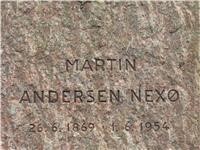Author Martin Andersen Nexø (1869-1954)
Martin Andersen Nexø was a Danish writer and the first significant author in this country to depict the working class in his writings. His best-known work and the one most translated is Pelle the Conqueror, completed in 1910, and made the subject of a movie by the Danish director Bille August in 1987.
Martin Andersen Nexø was born to a large family in an impoverished district of Copenhagen, Denmark. In 1877, his family moved to Nexø, Bornholm, and he adopted the name of this town as his last name.
In 1910, he joined the Social Democratic movement and later the Communist Party of Denmark. His later books reflect his political support of the Soviet Union.
Danish police arrested Nexø in 1941 during Denmark's occupation by the Nazis for his communist affiliation. Upon his release, he traveled to neutral Sweden and then to the Soviet Union, where he made broadcasts to Nazi-occupied Denmark and Norway. After WW II, Nexø moved to Dresden in East Germany where he was made an honorary citizen. He died in Dresden in 1954 and was interred in Assistens Kirkegård after a very big funeral, attended by many state leaders from Eastern Europe.

Martin Andersen Nexø was a Danish writer and the first significant author in this country to depict the working class in his writings. His best-known work and the one most translated is Pelle the Conqueror, completed in 1910, and made the subject of a movie by the Danish director Bille August in 1987.
Martin Andersen Nexø was born to a large family in an impoverished district of Copenhagen, Denmark. In 1877, his family moved to Nexø, Bornholm, and he adopted the name of this town as his last name.
In 1910, he joined the Social Democratic movement and later the Communist Party of Denmark. His later books reflect his political support of the Soviet Union.
Danish police arrested Nexø in 1941 during Denmark's occupation by the Nazis for his communist affiliation. Upon his release, he traveled to neutral Sweden and then to the Soviet Union, where he made broadcasts to Nazi-occupied Denmark and Norway. After WW II, Nexø moved to Dresden in East Germany where he was made an honorary citizen. He died in Dresden in 1954 and was interred in Assistens Kirkegård after a very big funeral, attended by many state leaders from Eastern Europe.

20